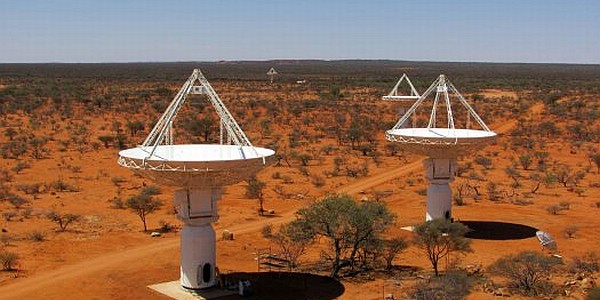The Australian Square Kilometer Array Pathfinder (ASKAP), part of the
future Square Kilometer Array (SKA), will soon start work. ASKAP
contains 36 antennas, each 12 m in diameter, spread across 4 km but
working as a single telescope. The SKA will consist of many thousands of
antennas spread across Australia and South Africa.
The Biggest Story Ever Told
By
Abraham Loeb and Jonathan Pritchard
New Scientist, October 29, 2012
Edited by Andy Ross
The universe is now 13.7 billion years old. A flash that bathed the cosmos
in light 400,000 years after the big bang during the epoch of recombination
when atoms formed gives us a snapshot of its infancy. Radiation from that
flash is now the cosmic microwave background. Tiny variations in its
temperature show how the atoms were clumped.
Gravity pulled the atoms
into stars and galaxies. The first stars consisted solely of hydrogen and
helium and were monsters that burned bright and died within a few million
years. Nuclear reactions within them created the heavier elements that went
into the mix for later stars and planets. Their high-energy radiation
ionized hydrogen atoms from the epoch of recombination. This epoch of
reionization, which is thought to have ended some 700 million years after
the big bang, gave rise to the cosmos we see today.
The center of
every spiral galaxy seems to host a black hole with a mass millions or
billions of times that of the sun. One theory is that they began as
star-sized black holes and slowly grew by sucking in gas and surrounding
stars. Yet a typical supermassive black hole would need longer than the age
of the universe to swallow enough material. Another theory is that they were
just born big. We don't know whether UV light from the first stars or X-rays
from the growing black holes caused the epoch of reionization.
Neutral hydrogen gas was abundant in the cosmos between the epochs of
recombination and reionization, and it gives off a faint radio signal that
we can detect. The electron and proton within each hydrogen atom act like
two bar magnets that can lose energy when their spin flips. A flip to
opposite directions releases energy as a photon with a radio wavelength of
21 cm. A flip into the aligned state can occur by absorbing a passing
photon.
The emission or absorption of 21 cm radiation over patches of
sky is a sure sign that hydrogen atoms are present. Because hydrogen is
ionized by high-energy radiation from stars or galactic black holes, it can
help us map the distribution of stars and galaxies. Hydrogen emissions from
the first billion years after the big bang are stretched by cosmic expansion
to wavelengths of around 2 m. The longer the wavelength, the larger the
telescope required to detect it with the necessary resolution.
In a
radio telescope, incoming photons from a distant source overlap and are
recorded as a single continuous wave. This wave can be sampled at different
points by many widely distributed small antennas and combined by computer
algorithms into a coherent signal. Because Earth's ionosphere interferes
with radio waves, the signal is corrected by referencing coordinates to a
network of radio pulsars. Individual bright radio sources, diffuse radio
emissions from our own galaxy, and human radio noise can be filtered out.
The first definitive detection of hydrogen from the epoch of
reionization is expected within the next five years. The Square Kilometer
Array (SKA) in South Africa and Australia, to be completed in Australia by about 2020, with
many thousands of radio antennas over a baseline of 3,000 km offering a
total collecting area of one square kilometer, plugged into a
supercomputer, will give us a better view. NASA is examining a possible
21 cm observatory on the far side of the moon.
AR This is a great story. Hope I live long enough to see some good results.
|
|
|
